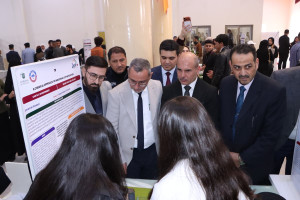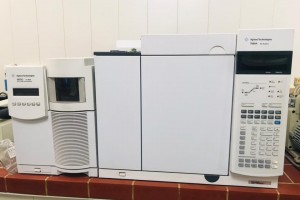
The College of Education for Pure Sciences, Department of Chemistry, University of Basra, discussed a high diploma thesis on (studying the properties of ethanolic extract as an antioxidant, anti-bacterial and anti-human liver cancer)
The thesis presented by the researcher (Alaa Adnan Yousef) included the preparation of the ethanolic extract of the leaves of the Salicornicum plant using the extraction method in the microwave device, and the chemical compounds contained in the ethanolic extract of the leaves of the Salicornicum plant were analyzed using the GC-MS device. It was noted that this plant contains several biologically active compounds such as (esters such as Phytol acetate, alcoholic compounds such as octan-8-ol, carboxylic acids such as n-Hexadecanoic acid and other active compounds such as Heptacosane and Octasiloxane). The highest peak was for the compound Gamma-Sitosterol at a relaxation time (Rt=35.057), and four intense peaks appeared for the compounds n-Tetracosanol-1, 9,12,15-Octadecatrienoic acid, n-hexadecanoic acid and Glycine, N,N-dimethylester At (Rt=30.005 and Rt=24.078 and Rt=22.341 and Rt=6.415), respectively.
Then the efficiency of the ethanolic extract of Salcuronicum leaves was measured as an anti-oxidative stress and compared with vitamin C as a positive control factor by (DPPH) assay using different volumes of extract (10- 80) µg/ml and using an ELISA device at wavelength 490 nm, where the color change was observed. From purple to light yellow when the concentration was increased, GraphPad Prism 8.1 program was used to analyze and calculate IC50. Accordingly, it was found that the ethanolic extract of the leaves of the jamar plant possesses an average antioxidant activity, as the IC50 value reached 4.120 µg/ml compared to vitamin C, which has anti-oxidant activity. Strong oxidation, which is equal to 4.898 µg/ml. The efficacy of the ethanolic extract of Salicornicum leaves against human hepatocellular carcinoma cells (HCAM) was evaluated. The activity of the ethanolic extract of cycloronicum against four types of pathogenic bacteria was measured, as it gave the inhibition area (9 mm) for two types of bacteria (Staphylococcus aureus and Escherichia coli).
Objectives of the study :
And the use of microwave technology in the process of extracting the leaves of the plant, ethanol, and the analysis of the chemical components of the ethanolic extract of the leaves of the plant using the technique of gas chromatography-mass spectrometry (GC-MS).
And evaluation of the efficiency of the ethanolic extract of the leaves of the gammar plant as an antioxidant.
And evaluation of the efficiency of the ethanolic extract of the leaves of the plant as an anti-liver cancer. And the evaluation of the efficiency of the extract of the leaves of the plant as an antidote to four types of bacteria, and the comparison of the efficiency of the ethanolic extract of the leaves of the leaves of the plant of the plant with a chemical drug used in the treatment of liver cancer on normal cells and in the form of human liver cancer cells using a dye acridine/ethidium bromide








